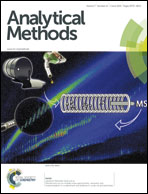The use of DNA self-assembled gold nano-rods for novel analysis of lead and/or mercury in drinking water
Abstract
A novel, uncomplicated method for the analysis of lead (Pb2+) and mercury (Hg2+) ions has been developed with the use of gold nano-rods (AuNRs), which were combined with ssDNA. The AuNR–ssDNA assembly was stabilized by electrostatic interactions. The ssDNA has a random coil structure, which was changed to G-quartet and hairpin-like structures after binding with Pb2+ and Hg2+ ions, respectively. The bonding with lead and mercury caused the ssDNA assembled AuNRs (ssDNA–AuNRs) to disperse, and this increased the surface plasmon resonance (SPR) absorption of the AuNRs. Changes in the UV-vis spectral intensities allowed the selective detection of Pb2+ and Hg2+ ions at concentrations as low as 19.8 nM and 3.2 nM, respectively. Linear correlations were observed between the UV-vis spectra and the Pb2+ and Hg2+ analytes in the concentration ranges of 25–250 nM (R2 = 0.9971) for Pb2+ and 4–40 nM (R2 = 0.9956) for Hg2+, respectively. The literature suggests that the novel method is another example in which the ssDNA–AuNR assembly has been used for trace analysis of Pb2+ and Hg2+.


 Please wait while we load your content...
Please wait while we load your content...